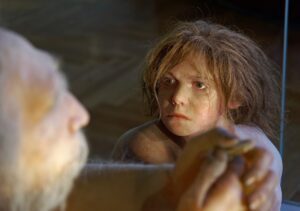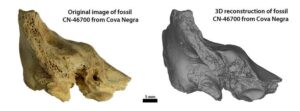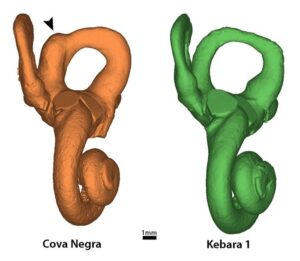
AMERICAN ASSOCIATION FOR THE ADVANCEMENT OF SCIENCE (AAAS)—Fossilized fragments from a Neanderthal child’s ear bear congenital malformations that are consistent with Down Syndrome, according to a new study*. The child lived past six years of age – a lifespan likely made possible by communal caregiving and collaborative parenting within the child’s Paleolithic community. Ancient humans and Neanderthals are known to have cared for their sick. One theory argues that caregiving emerged as a self-interested pact between participants who could reciprocate the behavior, while another hypothesis dictates that hominin caregiving was born out of altruism with no expectation for reciprocity. Prehistoric children with congenital diseases and/or injuries, whose survival to adulthood was uncertain at best, could not be counted on for reciprocation. Their lifespans can reveal how respective hominin communities perceived caregiving. Now, Mercedes Conde-Valverde and colleagues share evidence that suggests hominin caregiving emerged due to compassion rather than reciprocation. They describe fossilized inner ear bones from a child with a severe congenital ear pathology that is closely linked to Down Syndrome today. Excavated in 1989 from the Cova Negra archaeological site in the province of Valencia, Spain, these remains had traits associated with Neanderthals and developmental structures found in hominins over six years of age. They also contained signs of pathology, including a smaller cochlea and abnormalities specific to the shortest ear canal called the Lateral Semicircular Canal (LSC), which, together, cause hearing loss and disabling vertigo. “The only syndrome that is compatible with the entire set of malformations present in [the remains] is Down Syndrome,” Conde-Valverde et al. write. They explain that the child’s mother would have struggled to provide care while simultaneously keeping up with the daily challenges of a foraging lifeway in the Paleolithic. This, they conclude, suggests that “caregiving and collaborative parenting occurred together in Neanderthals and that both prosocial behaviors were part of a broader social adaptation of high selective value that must have been very similar to that of our species.”
_______________________________

Original temporal bone fossil and 3D reconstruction of Cova Negra fossil CN-46700 in anterior view. Julia Diez-Valero
_______________________________

3D models of the inner ear of Cova Negra fossil showing the dilatation of the lateral semicircular canal compared with Kebara 1, a Neanderthal that do not show the pathology. Julia Diez-Valero
_______________________________
Article Source: AAAS news release.
*The child who lived. Down Syndrome among Neanderthals? Science Advances, 26-Jun-2024. www.science.org/doi/10.1126/sciadv.adn9310
Cover Image, Top Left: Jakub Hałun, CC BY-SA 4.0, Wikimedia Commons
_______________________________
Advertisement



